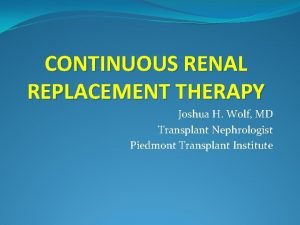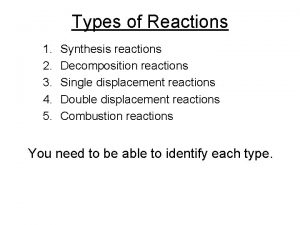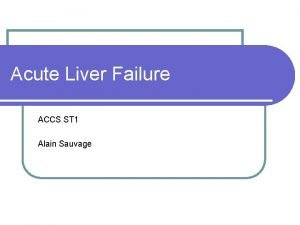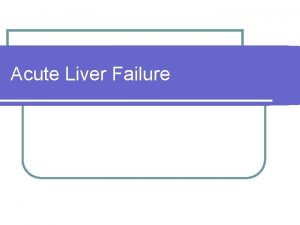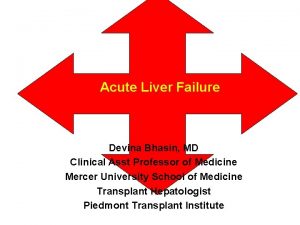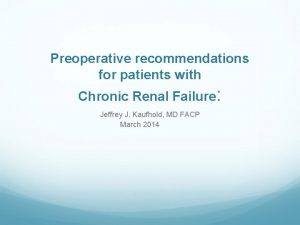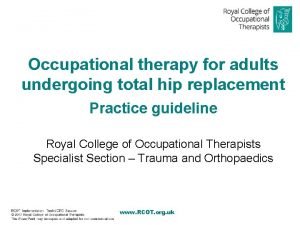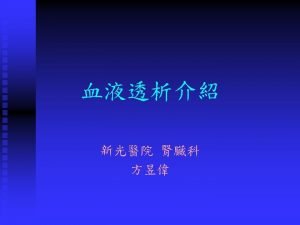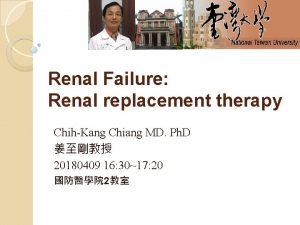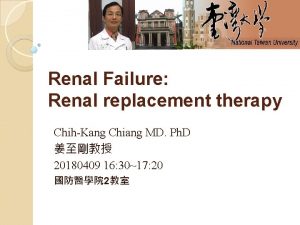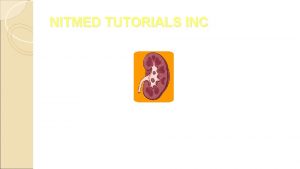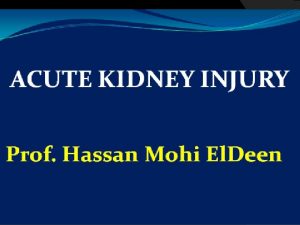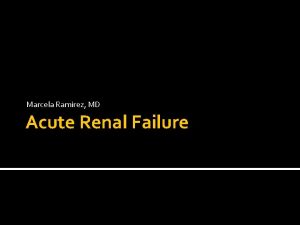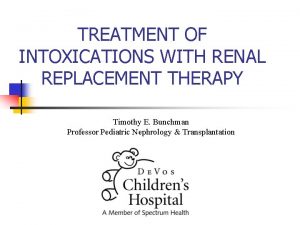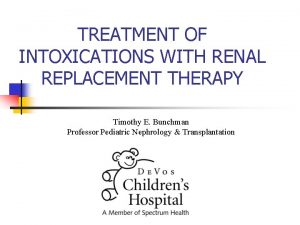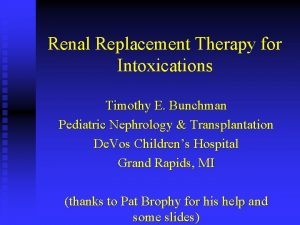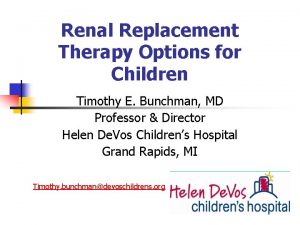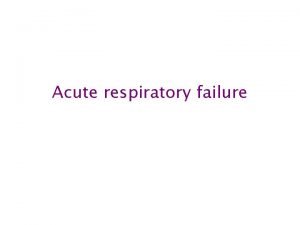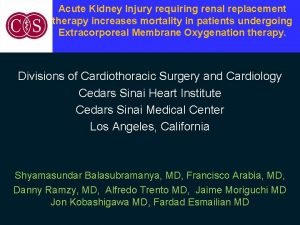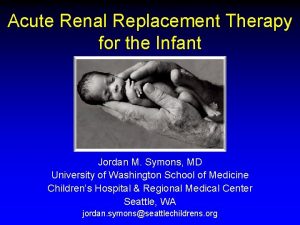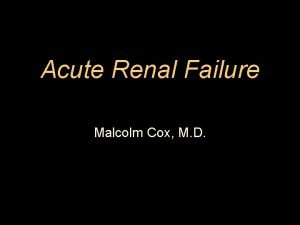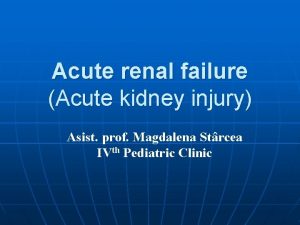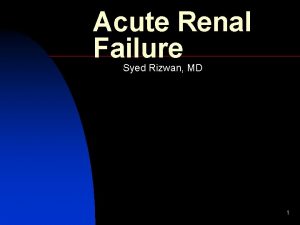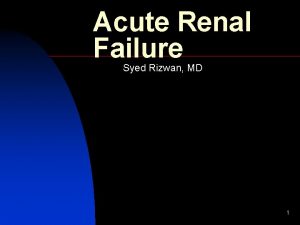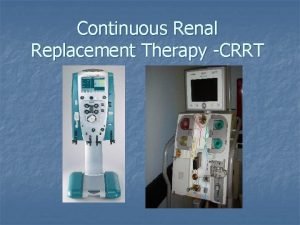Renal Replacement Therapy for Acute Renal Failure Timothy


























- Slides: 26

Renal Replacement Therapy for Acute Renal Failure Timothy E. Bunchman Professor Pediatrics

Infant ARF Single RRT Modality • Ronco et al; Intens Care Med, 1995 45% survival-CRRT • Sadowski et al; KI 1995 primary renal disease 71%-HD secondary renal disease 33%-HD bunchman

Pediatric ARF Single RRT Modality • Niaudet et al; KI, 1985 80% survival-primary ARF all RRT • Zobel et al; Ped Neph, 1989 65% survival-CRRT • Zobel et al; Contrib Neph, 1991 60% survival-CAVH, 35%-survival- CVVH bunchman

Pediatric ARF Single RRT Modality • Paret et al; J Thor Cardiovas Surg , 1992 33% survival-CAVH • Gallego et al; Nephron, 1993 52% survival with PD/HD features of poorer prognosis –less then 1 mos of age –hypotension bunchman

Pediatric ARF Single RRT Modality • Bradbury et al; Arch Dis Child, 1994 33% survival-CVVH • Latta et al; Ped Neph, 1994 37% survival-CAVH • Smoyer et al; JASN, 1995 43% survival-CRRT bunchman

Pediatric ARF Comparison of RRT modalities • Fleming et al; J Thor Cardiovas Surg, 1995 38% survival-PD 33% survival-CAVH 42% survival-CVVH • Maxvold et al; Am J Kid Dis, 1997 43% survival-CVVH 83% survival-HD bunchman

Pediatric ARF Comparison of RRT modalities • Lowrie et al; Ped Neph, 2000 – evaluation of PD vs CVVHF in children with MOSF – survival equal but related to disease state and the number of organs non functioning bunchman

Adult ARF Comparison of RRT modalities • Kruczynski et al; ASAIO, 1993 75% Survival-CAVH; 18% survival-HD • Bellomo et al; ASAIO, 1993 40% Survival-CRRT; 30% survival-HD • van Brommel et al: Am J Neph, 1995 43% Survival-CRRT; 59% survival-HD bunchman

New Dialysis Patients 1992 -1998 (total 354) bunchman

Demographics bunchman

Modality of Choice at onset bunchman

Diagnosis bunchman

ARF-282 patients • Time on therapy – HF-8. 7 days – HD-9. 5 days – PD-9. 6 days NS • Heparin Free Therapies – HF-51% – HD-28% bunchman < 0. 01

Survivors: Analysis by weight bunchman

Survivors: Analysis by BP at onset bunchman

Survivors: Analysis by use of Pressors bunchman

Survivors: Analysis by RRT modality bunchman

Survivors: Analysis by RRT modality and weight bunchman

Survivors: Analysis by Diagnosis and RRT Modality bunchman

Analysis by Diagnosis RRT Modality and Pressors bunchman

Survivors: Analysis by Diagnosis and RRT Modality bunchman

Analysis by Diagnosis RRT Modality and Pressors bunchman

Survivors: Analysis by Diagnosis and RRT Modality bunchman

Analysis by Diagnosis RRT Modality and Pressors bunchman

RRT for ARF • Best RRT is one that’s continuous, done with ease, and minimizes risk of hypotension, access complications, infectious risk, or coagulation risk • Best local standard is the best modality • Nutritional needs of the child need to be factored in and adjusted for RRT modality bunchman

RRT for ARF • Survival is related to diagnosis, hypotension, use of pressor agents and PRISM scores and may be influenced by RRT choice • ARF management needs to be a cooperative effort between Nephrologists and Intensivists for the optimal care of children bunchman
 Urinalysis
Urinalysis Ira pré renal renal e pós renal
Ira pré renal renal e pós renal Teoria do nefron intacto
Teoria do nefron intacto Aeiou renal replacement therapy
Aeiou renal replacement therapy Example of combustion reaction
Example of combustion reaction Hepatic coma stages
Hepatic coma stages Acute vs chronic heart failure
Acute vs chronic heart failure Liver failure criteria
Liver failure criteria Acute brain failure
Acute brain failure Cushings triad
Cushings triad Failure to fire pacemaker
Failure to fire pacemaker Site:slidetodoc.com
Site:slidetodoc.com Non conducted pac ecg
Non conducted pac ecg Renal failure
Renal failure Acute glomerulonephritis pathophysiology
Acute glomerulonephritis pathophysiology Earthy look in chronic renal failure
Earthy look in chronic renal failure Vasa recta vs peritubular capillaries
Vasa recta vs peritubular capillaries Major physiological anions
Major physiological anions Occupational therapy intervention plan for hip arthroplasty
Occupational therapy intervention plan for hip arthroplasty Nicotine replacement therapy side effects
Nicotine replacement therapy side effects Psychoanalytic vs humanistic
Psychoanalytic vs humanistic Bioness bits cost
Bioness bits cost Humanistic therapies aim to boost
Humanistic therapies aim to boost Smärtskolan kunskap för livet
Smärtskolan kunskap för livet Argument för teckenspråk som minoritetsspråk
Argument för teckenspråk som minoritetsspråk Fimbrietratt
Fimbrietratt Frgar
Frgar



